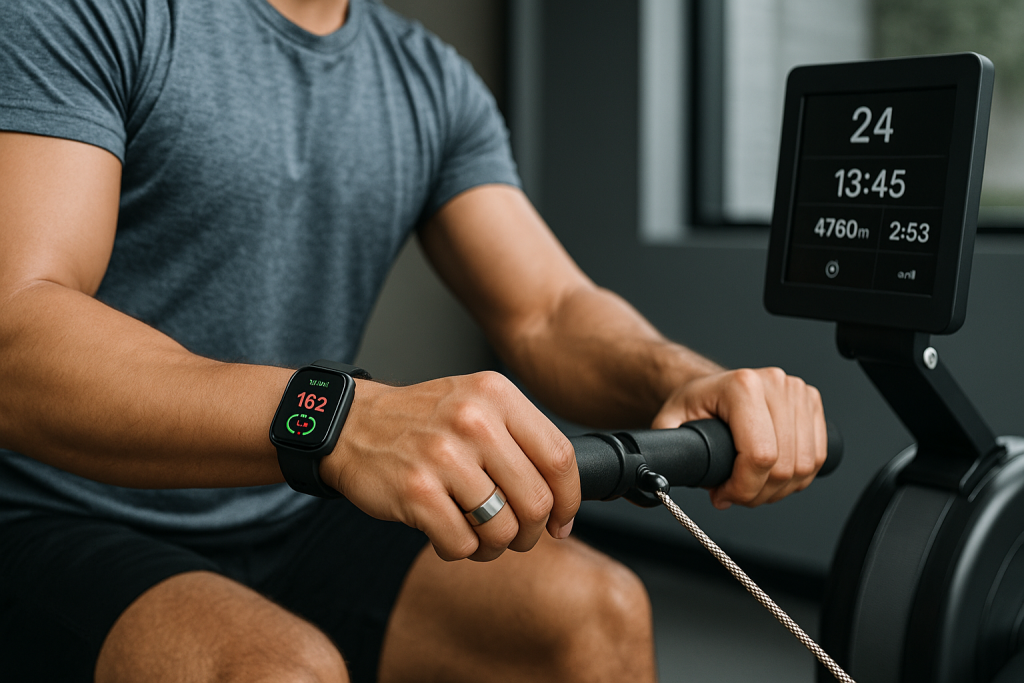Wearable tech in fitness is no longer just about step counting. As of 2025, it’s about data precision, AI-driven insights, and real-time health tracking that’s tailored to each user’s unique physiology. With the rise of smart rings, biometric sensors, and machine learning integrations, the way people train, recover, and monitor their fitness has changed dramatically.
This article takes a close look at the latest developments in wearable tech in fitness, explains why they’re catching on, and explores how they are influencing everyday habits, from gym sessions to mental well-being.

The Rise of Smart Rings and Minimalist Wearables
Fitness wearables are becoming smaller, more discreet, and far more capable. One of the most notable trends in 2025 is the widespread adoption of smart rings. Unlike bulkier fitness bands or watches, smart rings are compact and easy to wear around the clock.
Smart rings like the Oura Ring and Ultrahuman Ring Air now offer:
- 24/7 heart rate monitoring
- Blood oxygen saturation
- Temperature variation tracking
- Recovery and sleep quality scores
- Readiness metrics based on physical strain and rest
What makes this trend powerful is how it’s shifting user expectations—from simply tracking movement to understanding the body’s readiness for performance or recovery. These devices are especially popular among users focused on holistic wellness rather than just step goals.
Integration with Artificial Intelligence and Machine Learning
Another major development in wearable tech in fitness is the use of AI and machine learning to interpret health data. Fitness apps connected to wearables can now:
- Predict optimal workout times based on circadian rhythms
- Offer nutrition suggestions based on biometric feedback
- Identify patterns in training plateaus or fatigue
- Customize training plans daily
For instance, WHOOP’s algorithm adapts recommendations based on strain and sleep patterns. Similarly, Fitbit’s new AI features use personalized trend analysis to alert users to early signs of overtraining or stress.
These capabilities mark a shift from generic activity data to proactive health coaching.
Stress, Recovery, and Mental Wellness Tracking
Fitness is no longer seen in isolation from mental health. That’s why new wearables are adding stress detection and HRV (heart rate variability) tracking into their core offerings.
In 2025, most mid-to-high-end wearables offer:
- Guided breathing exercises when elevated stress is detected
- Notifications for irregular heart rhythm or elevated resting heart rate
- Sleep stage tracking that factors into mood recommendations
Garmin, for instance, uses Pulse Ox and HRV data to score mental readiness. Apple Watch continues to refine its mindfulness reminders based on movement and heart rate trends.
This integration is particularly valuable as more users shift focus to overall well-being instead of performance alone.
Real-Time Feedback for Form and Injury Prevention
One emerging use case of wearable tech in fitness is real-time biomechanical feedback. Companies like FORM and STRAFFR are pioneering this by embedding sensors into smart goggles and resistance bands, helping users correct posture and optimize movement during training.
What makes this significant:
- Wearables can reduce injury risks by providing haptic alerts for poor form
- They allow for remote coaching based on live data streams
- Athletes gain access to metrics like stroke efficiency (for swimming), gait analysis (for runners), or joint movement tracking (for strength training)
This kind of granular, actionable feedback wasn’t available in the consumer fitness space a few years ago. Now, it’s part of the mainstream wearable ecosystem.
Data Privacy and Ethical Concerns
As wearable tech in fitness becomes more data-intensive, privacy concerns have also grown. In 2025, a major talking point is the ethical use of biometric data. Questions arise around:
- Who owns the data—user or the device manufacturer?
- How are third-party apps accessing or selling fitness data?
- Are insurers using health metrics from wearables to adjust rates?
Users are increasingly choosing brands that offer data transparency and local device storage. For example, Polar and Garmin have been praised for avoiding cloud-based data storage unless explicitly enabled by the user.
Awareness around these issues is driving demand for privacy-conscious tech and user-controlled settings.
Wearable Tech for Niche Fitness Communities
Wearable fitness tech is also expanding into more specialized sports and communities. Examples include:
- Cyclists using power meter sensors paired with wearables to monitor output and cadence
- Climbers using altimeter and heart-rate integration to measure aerobic capacity in high-altitude settings
- Women-specific fitness tracking focusing on cycle syncing and hormone-level awareness
These tailored solutions show how wearable tech is moving away from one-size-fits-all and catering to the specific needs of user subgroups.
Practical Tips for Choosing a Wearable in 2025
If you’re considering upgrading or starting with wearable fitness tech this year, keep the following in mind:
- Purpose Matters: Choose based on your primary goal—general wellness, athletic performance, sleep tracking, or recovery.
- Compatibility Counts: Make sure it integrates with your preferred apps or platforms (Apple Health, Google Fit, Strava, etc.).
- Battery Life: Newer smart rings last up to 7 days, while feature-heavy smartwatches may need daily charging.
- Subscription Models: Some wearables now require a monthly fee for full feature access (e.g., WHOOP, Fitbit Premium).
- Privacy Settings: Opt for brands with strong encryption and clear policies on data ownership.
These considerations help avoid buyer’s remorse and ensure long-term value from your device.
Final Thoughts
Wearable tech in fitness has grown beyond its early role of counting steps. In 2025, it’s a connected ecosystem that monitors, predicts, and guides personal health in real time. From AI-driven coaching and smart rings to stress tracking and privacy controls, the evolution of this technology is reshaping how we approach wellness.
As the market expands, both casual users and serious athletes benefit from more personalized, intelligent, and seamless integrations—making fitness smarter and more responsive than ever before.
References
- WHOOP Official Site – https://www.whoop.com
- Oura Ring Features – https://ouraring.com/features
- Garmin Health – https://www.garmin.com/en-US/health/
- Apple Health and Fitness – https://www.apple.com/apple-fitness-plus/
- Polar Privacy Policy – https://www.polar.com/en/legal/privacy-notice






